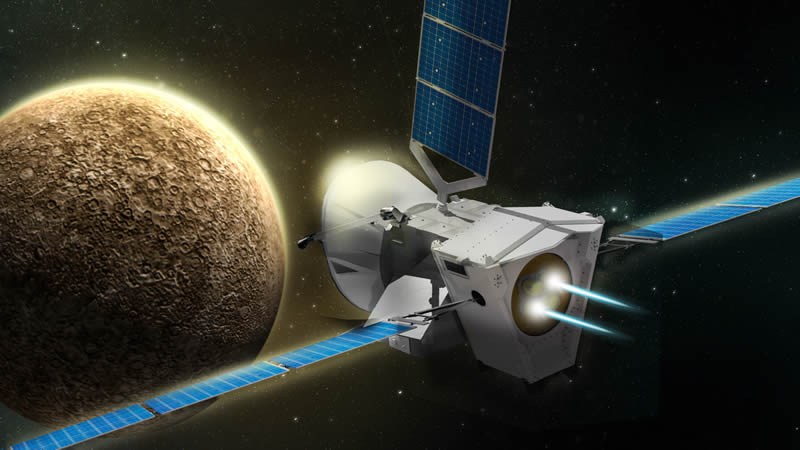Work-in-Space News2017-07-06 09:39:25
BepiColombo - a four in one satellite to uncover Mercury´s mysteries
In a 6.4-metre stack, the spacecraft is undergoing final testing in flight configuration
Mercury remains the most mysterious planet of our inner Solar System. BepiColombo, Europe's first mission to Mercury, will set off in October 2018 on a journey to the smallest and least explored rocky planet in our Solar System.
The European Space Agency (ESA), the Japanese Aerospace Exploration Agency (JAXA) and Airbus - the industrial prime contractor leading a consortium of 83 companies from 16 countries - laid out the scientific goals of the mission and presented the impressive four element spacecraft, in a final viewing before its launch next year.
Piled up in a 6.4 metre high stack, the 4 tonne BepiColombo spacecraft is close to finishing its test campaign. It will be shipped to Europe´s spaceport Kourou in French Guiana in March 2018.
The Sun’s glare makes it impossible to study Mercury in detail using telescopes and the extreme heat and proximity to the Sun make it hard to reach. So far, only two NASA missions have visited Mercury: Mariner 10 in the 1970’s and Messenger, which orbited the planet from 2011 until it ran out of fuel in April 2015.
ESA and JAXA have teamed up for the mission BepiColombo.
Named after the Italian professor Giuseppe ‘Bepi’ Colombo, who was instrumental in making the Mariner 10 mission such a success, the mission is made up of two separate orbiters, the Mercury Planetary Orbiter (MPO supplied by ESA) and the Mercury Magnetospheric Orbiter (MMO supplied by JAXA).
The BepiColombo mission will examine the peculiarities of Mercury´s internal structure and magnetic field generation, and how it interacts with the Sun and solar wind.
It will investigate surface features and chemistry, such as the ice in permanently shadowed craters at the poles. The mission's science will significantly improve our understanding of the formation of our Solar System, and the evolution of planets close to their parent stars.
Today is the last time that the complete stack will be on view in Europe.
After testing the connection and separation systems with the Launch Vehicle Payload Adaptor System from Arianespace in late July the spacecraft will be disassembled by testing its module separation systems. Additional functional and performance checks will follow the mechanical test programme and then a final thermal test of the Transfer Module will be performed in November.
At the end of March 2018, the spacecraft will be shipped to Kourou. Once in French Guiana, the team will reassemble the stack and install it on the Ariane 5 launch vehicle, with launch scheduled for October 2018. After a seven-year cruise, the Transfer Module will be ejected and the remaining modules will reach Mercury in December 2025.
